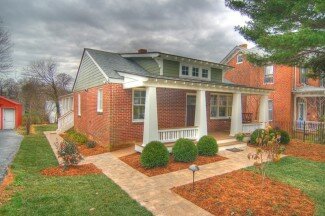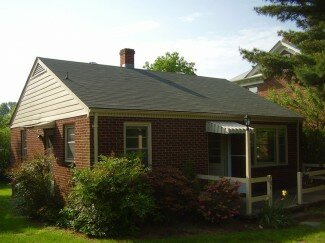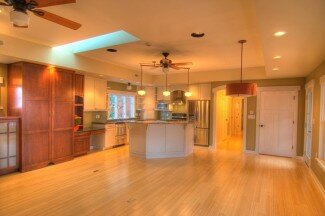Boomer boom: renovation allows couple to stay put
 Instead of moving to a retirement community, Lynne and Don Gardener had their Lexington Avenue house rebuilt for their needs.
Instead of moving to a retirement community, Lynne and Don Gardener had their Lexington Avenue house rebuilt for their needs.PHOTO COURTESY ABRAHAMSE & COMPANY
Like so many of the estimated 78 million Baby Boomers circling the retirement ages, Charlottesville residents Don and Lynne Gardner began to think about where and how they wanted to live as they grew older. At age 70, Don had begun battling memory loss, and he required dialysis. And Lynn, a 65-year-old registered nurse, was beginning to worry about the basement stairs her husband insisted on negotiating to get to his beloved workbench.
They had raised two sons in their 38 years in the Hazel Street house, but Lynn began asking herself hard questions: “Could he continue to navigate the basement steps or the second floor and the numerous stairs? How safe was it for us to stay?”
But they didn't need assisted living, and they weren’t thrilled about the concept of a retirement community.
“We visited places that were touted as being for seniors,” says Lynne. “We would be surrounded by other seniors, but being around people of all ages, and kids, that’s what keeps you young.”
So Lynne and Don set out to find a smaller, senior-friendly designed house where they could “age in place.”
The Hazel Street house, which they’d bought for $14,000 in 1972, was recently assessed at $243,000, and the first home they bought on nearby Lexington Avenue for $11,300 in 1962, and had decided to keep as a rental property, was recently assessed at $285,000. The idea was to try and sell the Hazel Street house, and perhaps the Lexington Avenue house, which would leave them in good shape to buy a smaller house.
 A before shot of the the Lexington Avenue house, which the Gardners bought in 1962 for $11,300.
A before shot of the the Lexington Avenue house, which the Gardners bought in 1962 for $11,300.PHOTO COURTESY ABRAHAMSE & COMPANY
However, while Charlottesville is often touted as an attractive retirement destination for all those Boomers and offers several assisted living facilities, the Gardners discovered there weren’t many destinations they'd call home, especially in their price range.
“It’s slim pickens for seniors out there,” says Lynne. “There are just not many houses in town designed for seniors.”
And that would be houses with a master bedroom, kitchen, bathroom, and laundry all on the first floor–- plus easy access to the street.
Indeed, according to local realtor Jim Duncan, who picked up on this trend in 2005, out of the 1158 homes currently on the market in the Charlottesville/Albemarle area for under $1 million, only 143 have bedroom, kitchen, and laundry on the first floor, never mind a full bathroom.
“I have not found many houses/developments that incorporate Universal Design,” says Duncan.
Universal design?
“It’s a holistic approach to designing a home,” explains Richmond architect Burt Pinnock, pointing out that it’s based on creating homes that accommodate the needs of the elderly and physically disabled, “but without looking like a house for the disabled or elderly.”
For example, instead of stairs leading to the front door, there’d be a discreet ramp that could later be equipped with grab bars. Doorways and hallways would be wider to accommodate a wheelchair. Or there might be grab bars in the bathroom that looked and functioned as towel racks.
As luck would have it, much of Pinnock’s recent experience with universal design would come from working with the Gardners. Unable to finding suitable homes reasonably close to Downtown, one of the Gardners' sons, David, suggested they sell their house and consider remodeling the Lexington Avenue house. And Pinnock was an old friend.
“When your friend asks you to help design a home for their parents,” says Pinnock, “you can’t say no.”
Ironically, then, the Gardner’s first house would become their last.
Luckily, the Gardners were able to sell the Hazel Street house last November and move into the renovated Lexington Avenue property. The old house sold for $221,000, slightly under assessment, but enough to cover most of the seven-month, $300,000 renovation.
“The goal,” says Lynne, "was not to have a mortgage."
 Note the discreet dialysis cabinet to the left, the ample lighting, and the wide hallways and doors.
Note the discreet dialysis cabinet to the left, the ample lighting, and the wide hallways and doors.PHOTO COURTESY ABRAHAMSE & COMPANY
The house was essentially gutted, and a 600 square-foot addition was added. Features include discreet ramps, wheelchair-accessible counters and passageways, a washer and dryer on a pedestal (to eliminate the need to bend over), and even a discreet dialysis cabinet where Lynne can check on Don while she cooks. A medical alert system puts little push-buttons in various places, and the toilets are elevated. Still, as Lynne points out, the house doesn’t look like “somebody in a wheel chair lives here.”
The house also incorporates plenty of ââ?¬Ë?green” features, including Icynene sprayed-foam insulation, HardiePlank siding, Trex decking, bamboo flooring, a tankless gas water heater, and Energy Star appliances.
“The big challenge was to get them to visualize and verbalize what they wanted,” says Pinnock, who points out that some of the features are particularly subtle. “From his bedroom, Don can see his work desk and the bathroom. These visual connectors were important to him.”
Another challenge was finding a builder.
“We spoke to many builders about our desired renovation and most balked at the idea,” said Lynne.
Fortunately, Charlottesville’s Abrahamse & Company Builders was up to the challenge.
“For years," says company owner Dale Abrahamse, "we’ve been interested in building high performance homes. But when you think about it, creating spaces that are accessible and allow people to age in place should also be a consideration in high performance.”
“We desperately need this in this community,” says Lynne, “but most builders are just not tuned into building places for seniors.”
“We’re starting to have parents that are getting older,” says Pinnock of himself and his associates, “so the idea of universal design is becoming more personal to us. We certainly recommend that seniors look at adapting what they already have. Psychologically for seniors, I think, staying in the same place is good, and it’s also sustainable.”
11 comments
I'm amazed there aren't more of these "aging in place" retrofits
happening in the City. One would think with all the cute bungalows that need re-habing, are close to downtown and the university, and on transit routes; that seniors would be grabbing them, now that the price is right and there are lots of ready workers.
This article is beneficial for families with loved ones considering an assisted living facility. This is a good option.
Dave...why did most builders balk at the idea?
ARGH. Please look up the correct spelling of "discreet" with the meaning that you intend. You did this twice.
Almost as bad as "Hepatitus" in another article. Shades of The Observer.
Great article, bad lede. The Baby Boom didn't start until 1946. They're not Boomers.
I feel this is a great idea !
My grandparent's single biggest fear was having to leave their home when they aged . In 2002 we did a complete remodel and redesigned the home around them . Get the right contractor and they think of every little detail needed for the aging . The coolest thing was the yardscaping , not a single blade of grass to mow ( my granddad said he wished he would have thought of that 50 years ago lol ). Both my grandparent's enjoyed their home of 53 years to the end . They both lived independently to the age of 80 in their own home .
Dakota
not even
How can someone walk away from an informative article absorbing nothing but pointing out a misspelling or error in grammar to comment on .
Have we really became this simple minded .
Dakota
The most interesting part of this story is the one yet to be told...
You know all those huge McMansions out in the county on 20+ acres? Guess what, they are almost all populated by baby boomers. What's going to happen when they all start making the kinds of decisions that the Gardner's have made?
First of all, I think you can expect the prices of apartments and townhouses to start going up dramatically (perhaps pricing out lower income folks) and then all those huge homes will be dumped on the market with no one to buy them. That will be on a market that's already flooded with huge homes that no one wants to buy right now.
Are you ready for the Sequel to the Economic Crisis? Because, it's looming on the horizon right now... It will take strong leadership from local government to keep us from sliding into this next financial abyss. It must begin with the realization that rural protection is key to our economic vitality, and that building more rural homes for boomers is a disaster waiting to happen.
I think ADU (Accessory Dwelling Units) would supply the market the author talks about in the article. These units allow for the possibility of any seniors who own a home in Charlottesville to build a small house in the rear of their yards, and rent out the larger house they used to live in. Banks are now lending based on the equity in the main house for these kinds of improvements. There is a very interesting case on Park Ave where a couple built an ADU on their property and their children's family moved into the larger existing house. This is a multi-generational, family building example of the power of ADU's. Not to mention that it allows seniors financial flexibility to age in place, generated income on their home's value.
What a wonderful job of renovation! This project is an inspiration to any family that wants to make the most of a house that has gotten a little run down. The critical element is to invest in a house that needs some help but is located in a great neighborhood. Congratulations to the Gardners!
[...] The house also incorporates plenty of ââ?¬Ë?green” features, including Icynene sprayed-foam insulation, HardiePlank siding, Trex decking, bamboo flooring, a tankless gas water heater, and Energy Star appliances.[...]